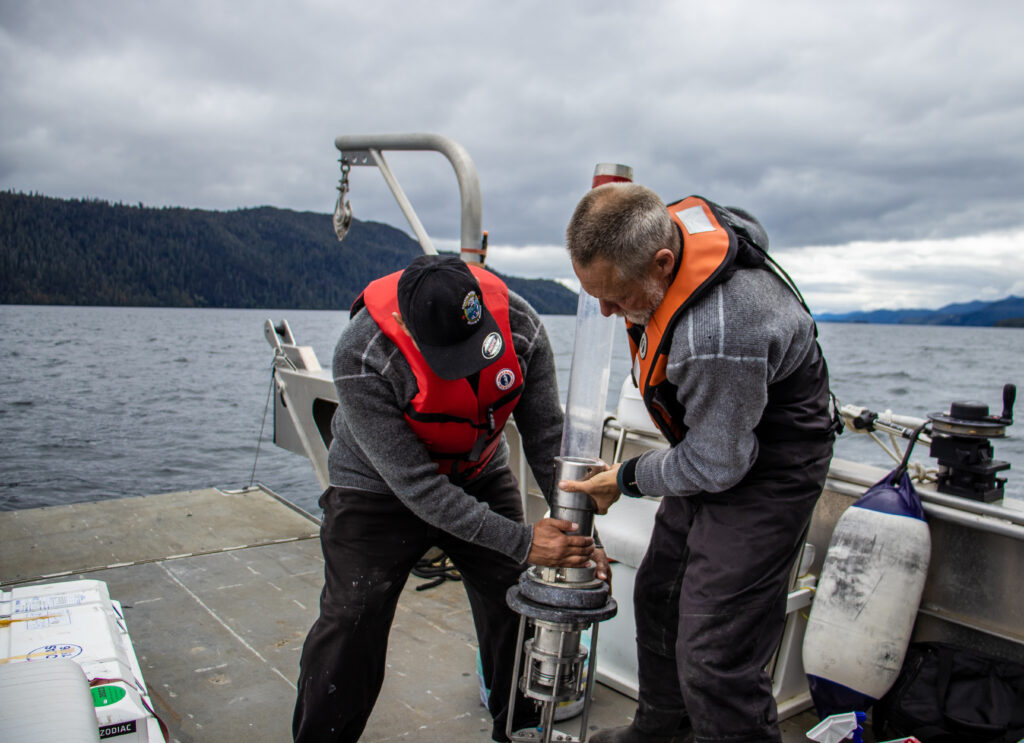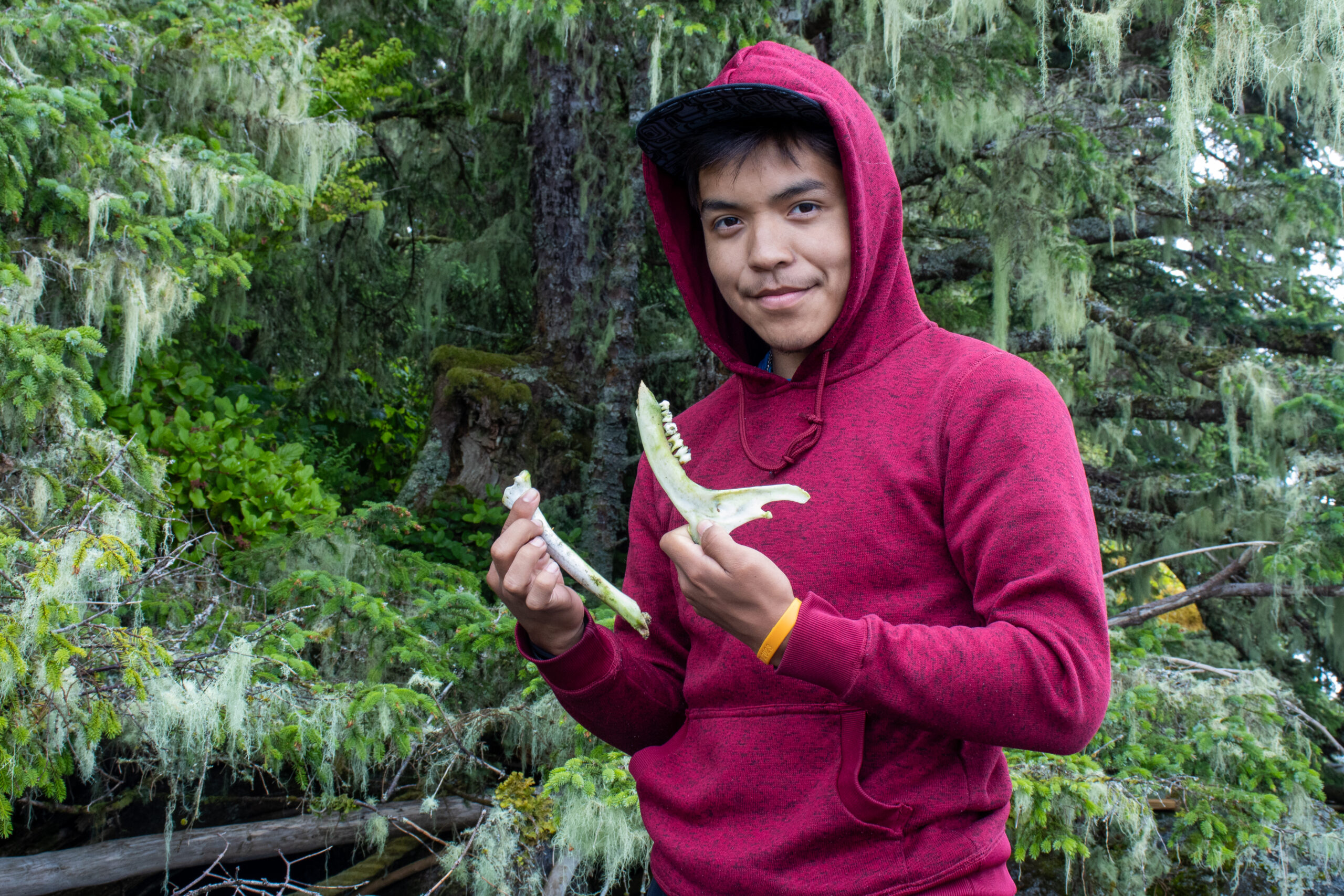Coastal First Nation’s forest carbon financing model generates carbon offsets through sustainable management practices and uses revenue generated to support coastal conservation and stewardship.
In 2009, CFN and BC signed the Reconciliation Protocol and validated one of the largest carbon offset projects in existence, the Great Bear Forest Carbon Project. The project includes changes in land-use legislation and regulation from extraction to conservation practices that result in tonnes of carbon offsets available to sell in local or international carbon markets.
Improved forest management
Corporations Manager David Oxley and Corporations Administrator Dani Warren say CFN’s carbon offset projects provide economic, social and political incentive to protect and conserve forests across the Great Bear Rainforest (GBR).
“We liaise with the provincial government on various carbon issues, manage inventories, look after direct sales, our own sales, and our sales network, which has about eight different partners,” says Oxley.
“A big part of our work is communicating about the projects with interested parties, researchers, and other Nations that want to hear what we’ve done and the challenges we’ve seen in the marketplace and in general,” adds Warren.
CFN works on a number of different carbon offset programs, including a Haida Gwaii carbon project and a North Central Coast carbon project, which involves six CFN First Nations. The Haida Nation owns 80 percent of the tonnes issued from the Haida Gwaii carbon project. The other 20 percent is divided — 10 percent goes into an insurance buffer pool required by the province, another 10 percent to support a forum (an ad hoc committee composed of two provincial reps and two CFN project reps) who work on marine protected areas, blue carbon potential and future projects.
The other North Central Coast project is more complicated, the tonnage divided between the insurance pool, the committee and the six CFN Nations who have signed on, Oxley says. There are key differences between each carbon offset project.
“In our case, we have the ‘forest carbon project,’ from which we get our offsets. It’s about improved forest management. The offsets come from a change in behaviour.”
Offsets are generated by calculating avoided deforestation or degradation impacts across the GBR. The changed behaviours that produce carbon offsets include logging sustainably, planting forests in areas they haven’t been before (afforestation) and replanting forests where they have been absent for a long time (reforestation). When a project is validated, there’s a baseline of common practices established, which is then compared to the impacts of conservation practices.
“Without having trees logged, that adds in more carbon sequestration in the area, adding to the tonnage,” Warren says. The difference between “what would have happened and what is happening” is where carbon offsets are generated.
Warren says they have seen an increase in offsets in volume since the Haida Gwaii project, which got going in 2012, because activities in the area have continued to improve sequestration over time.
“A timber supply review was done and our inventory has almost doubled,” she says.
So-called “private lands” are excluded from being reviewed for offset generation, as well as any designated parks or previous conservation areas.
“Forest carbon projects work for Indigenous groups, because they are on unceded lands,” Oxley says. “That’s where the changes can happen… annual cuts are reduced, new conservation areas are established and stewardship efforts supported.”
‘We don’t sell to every company that wants to buy’
In 2021, the world saw carbon offset sales pick up, Warren says.
“This last fiscal year was the largest our Limited Partnership has ever had.”
Both Warren and Oxley are well aware of the criticisms people have towards carbon offset programs as a solution for mitigating climate change and they say they hope people understand that CFN’s approach to carbon offsets differs from other programs in significant ways. CFN won’t sell carbon offsets to just anyone, they say, and the money generated through the market go directly back into the communities who have been protecting their territories for generations.
“There are other carbon projects in BC,” Oxley says. “Like a pulp mill, if it replaces gas-driven drives with electric drives, it can get offsets, because it has made a change, which reduces its emissions. There are a number of pulp and lumber mills who have done that, gas facilities too, so they can have some offsets and the money goes into their revenue. Our money goes into enriching the territories — the language programs, Elders programs, traditional governance, and stewardship.”
It also matters who CFN will or won’t sell to, Warren adds.
“One of our principles is our sales guidelines. We don’t sell to every company that wants to buy offsets. We say, ‘we have these offsets, but we’re not going to sell to you, because we don’t like the work you’re doing,’” Warren says. “We’ve had a company with decades of history of damaging and destroying Indigenous territories that has tried to buy our offsets. We said no. If we sell to someone, that means we’re OK with them saying they’re connected to our Nations.”
Offsets are only sold to companies that reflect the Nation’s goals, aspirations and beliefs about conservation and climate change, she says.
“We’ve turned down millions in sales, millions when we didn’t have a lot of sales,” says Oxley. “Clients should be changing their behaviour, working on their operations by making them as minimal as possible, before buying offsets. We look at our buyers, their behaviour, what efforts they’re already making. A lot of companies will make a lot of the right noises, but you look at the overall activity and the story isn’t good.”

‘A community-based band-aid solution’
The carbon offset projects are a tool for mitigating climate change, Oxley says, one of many different kinds of nature-based solutions that provide incentive to protect and preserve the natural world, rather than extract from it. But it’s a temporary “band-aid solution,” he says.
“We think it’s important to stress that the money generated from these projects goes directly back to our communities and the Great Bear Rainforest itself. Before, it was being systematically cut down. There’s still logging, but at a much reduced level,” says Oxley.
There’s an increasing push for social responsibility, Warren adds, with the implementation of the United Nations Declaration on the Rights of Indigenous Peoples (UNDRIP) and government’s commitment to reach an emission reduction target of 40 percent below 2005 emissions by the year 2030 and net-zero emissions by 2050.
“Early this year, we sold 502 tonnes to a Brooklyn-based beauty company. They came with $10,000 and said they wanted to buy as much as they could and promote our work,” Warren says. “They wanted to know where the money goes and where they could see the benefits and we explained to them how their investment goes towards conservation, community development, protection and stewardship. We’re seeing social responsibility from a sustainability perspective grow.”
“There are companies out there that have amazing programs,” Oxley says. “There’s a gas distribution company in Oregon that wanted to sell to their customers, so they could offset the home heating emissions. They’re funding renewable natural gas projects in their region.”
One of the many projects that occupy Oxley and Warren’s time is the ongoing research into the potential for blue carbon sequestration. The Blue Carbon Quantification Methodology Project, which involves studying the amount of carbon stored in kelp beds and other deep marine life, is currently in its third year.
“We’re hoping to add a carbon offset component to future kelp farm development. Blue carbon offsets will sell for more… but we’re about two to three years away from that,” Oxley explains. “Once the methodology is complete, the decision will be made on where it will go next, the province or the voluntary market for protocol development? Once established, the plan is to connect with Nations and see where there’s interest for project development to start.”


